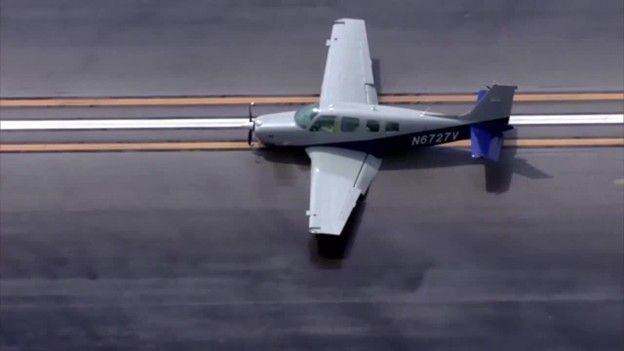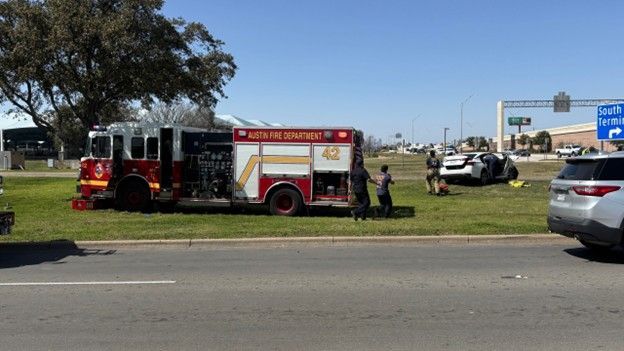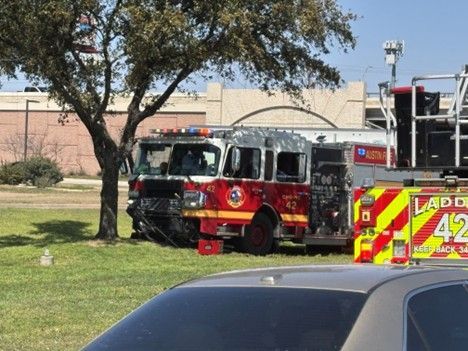ARFF Daily News
Published on:
Wednesday the 5th of March, 2025
Accident of a Saeta Peru Jetstream 32 in Güeppí: this is what we know
This is SAETA's third accident in three years.
Aviacionline
At 09:54 (local time) on Tuesday, a Jetstream 32 aircraft , operated by SAETA Peru and registered as OB-2178 , suffered a runway excursion in the border municipality of Güeppí, in the province of Putumayo, department of Loreto. All occupants survived the incident.
According to a statement from the airline, the 11 passengers and two pilots were unharmed. “All occupants were treated safely, verifying that there were no serious situations ,” SAETA reported.
For reasons still under investigation, the aircraft landed in Güeppí but was unable to brake in time, stopping 50 metres beyond the runway in a jungle area. Photographs of the site show that the plane suffered significant damage to its structure.
Güeppí Airport serves this town and the Tres Fronteras region, a sparsely populated area used by the Peruvian Armed Forces as a surveillance post on the border with Colombia and Ecuador, bordered by the Putumayo and Güeppí rivers. Due to its isolation, access to the area depends exclusively on air and river transport.
Impact of SAETA for the region
SAETA Peru is the main airline operating in these communities , providing an essential service in the Peruvian Amazon. The company has received government subsidies to offer discounts of up to 60% on tickets aimed at people with business needs, procedures, medical assistance and training.
This incident adds to other events recorded by the airline since its founding in 2017. In 2022, a Jetstream 32 registered OB-2152 failed to take off and collided with an embankment in San Antonio del Estrecho , also in the province of Putumayo. Although the aircraft was damaged, there were no casualties. The same aircraft had a previous incident in Tarapoto, when it was trying to take off at a flooded airport, which damaged its propellers.
A month later, a Cessna Grand Caravan, registered OB-2228, disappeared after taking off from San Lorenzo, Loreto. The aircraft was found in a swamp the next day, after an emergency landing due to engine failure. No casualties were reported.
Following these events, SAETA Peru suspended its operations pending an investigation by the competent authorities, resuming flights in early 2023. However, shortly after, a Cessna 206 from its fleet was stolen by alleged hitmen in Jeberos.
The recent incident in Güeppí raises concerns about air connectivity in the Peruvian Amazon, where more than 100,000 people depend on air transport, especially oil workers, military personnel and residents of isolated communities.
https://www.aviacionline.com/accidente-de-saeta-peru-en-gueppi-esto-sabemos


Plane makes emergency belly landing at North Perry Airport; no injuries reported
By Tynisa Senior, Brandon Beyer
PEMBROKE PINES, FLA. (WSVN) - A small plane made an emergency belly landing at North Perry Airport Tuesday morning.
Pembroke Pines Police said the plane made the emergency landing around 9:30a.m., due to failure with the landing gear.
The pilot escaped the plane unharmed and no other injuries were reported.
It’s unclear what caused the landing gear to malfunction.
The plane has since been towed away from the runway. The incident remains under investigation.

1 dead after crash involving Austin fire truck near airport
by: Kelsey Thompson, Andrew Schnitker
AUSTIN (KXAN) — One person died after a crash involving an Austin Fire Department truck and another vehicle near the Austin-Bergstrom International Airport Tuesday afternoon, Austin Police said.
The crash happened near State Highway 71 and Presidential Boulevard, adjacent to AUS, around 1 p.m. Airport officials confirmed Presidential Boulevard was closed for a period of time.
ATCEMS and APD said two adults were taken to St. David’s South Austin Medical Center, with one having critical, life-threatening injuries and the other having potentially serious injuries, medics said.
One of those adults was pronounced dead “a short time later,” APD said.
EMS crews evaluated four other patients for minor injuries following the crash, ATCEMS noted.
AFD Engine 42 originally dispatched to AUS in response to an airfield incident that has since been canceled, an AFD spokesperson told KXAN. While traveling to the airport, the spokesperson said the fire truck was involved in a crash with another vehicle.
“Two passengers from the vehicle were transported to an area hospital with injuries,” the spokesperson said. “The four firefighters that were on the apparatus were transported out of an abundance of caution.”
APD said the investigation into the crash is ongoing.
https://www.kxan.com/news/local/austin/multiple-injured-in-major-collision-near-austin-airport-tuesday/


NTSB Prelim: Vulcanair S P A Vulcanair V1.0
Engine Power Increased For About 2 Seconds, And Then The Engine Completely Lost Power
Location: Cheswold, DE Accident Number: ERA25LA113
Date & Time: February 7, 2025, 22:33 Local Registration: N186DS
Aircraft: Vulcanair S P A Vulcanair V1.0 Injuries: 2 Minor
Flight Conducted Under: Part 91: General aviation - Instructional
On February 7, 2025, at 2233 eastern standard time, a Vulcanair S.p.A V1.0, N186DS, was substantially damaged when it was involved in an accident near Cheswold, Delaware. The private pilot and pilot-rated passenger were uninjured. The airplane was operated as a Title 14 Code of Federal Regulation Part 91 instructional flight.
According to the pilot-rated passenger, the purpose of the flight was for the pilot to perform a cross-country flight to gain experience toward the pilot’s commercial pilot certificate. According to preliminary ADS-B data, the airplane departed from Delaware Airpark (33N), Dover, Delaware at 0906, and arrived at Myrtle Beach International Airport (MYR), Myrtle Beach, South Carolina at 1245. According to the pilot, prior to departing MYR, they refueled the airplane to full fuel tanks for the return flight to 33N.
At 1849, the ADS-B data revealed the airplane departed MYR and flew northeast. The pilot reported that they flew to Ocean City Municipal Airport, Ocean City, Maryland to perform a touch-and-go landing, followed by a flight to the Delaware Coastal Airport (GED), Georgetown, Delaware to perform another touch-and-go landing. After departing GED, they flew directly to 33N. When they were about 5 nautical miles south of 33N, the pilot maneuvered to the right base of the traffic pattern for runway 09 and descended to 1,000 ft msl. The pilot turned onto final approach when the airplane was about 2 miles from the approach end of the runway.
While on short final approach, the pilot realized he was low and added engine power to adjust his glideslope. The pilot reported that engine power increased for about 2 seconds, and then the engine completely lost power. The pilot determined that he had insufficient altitude to reach the runway and performed a forced landing in the grass area just prior to the approach end of the runway. Shortly after touchdown on the grass, the airplane nosed over, which substantially damaged the vertical stabilizer, rudder, and the left wing.
This information is preliminary and subject to change. The wreckage was retained for further examination.
FMI: www.ntsb.gov

Today in History
59 Years ago today: On 5 March 1966 BOAC flight 911, a Boeing 707-400, crashed near Mount Fuji, Japan, after encountering severe turbulence killing all 124 occupants.
Date: Saturday 5 March 1966
Time: 14:15
Type: Boeing 707-436
Owner/operator: British Overseas Airways Corporation - BOAC
Registration: G-APFE
MSN: 17706/113
Year of manufacture: 1960
Total airframe hrs: 19523 hours
Cycles: 6744 flights
Engine model: Rolls-Royce Conway 508
Fatalities: Fatalities: 124 / Occupants: 124
Other fatalities: 0
Aircraft damage: Destroyed, written off
Category: Accident
Location: Mount Fuji - Japan
Phase: En route
Nature: Passenger - Scheduled
Departure airport: Tokyo-Haneda Airport (HND/RJTT)
Destination airport: Hong Kong-Kai Tak International Airport (HKG/VHHH)
Confidence Rating: Accident investigation report completed and information captured
Narrative:
BOAC flight 911, a Boeing 707-400, crashed near Mount Fuji, Japan, after encountering severe turbulence killing all 124 occupants.
BOAC Flight 911 was a scheduled service from San Francisco (SFO) to Hong Kong (HKG) via Honolulu (HNL) and Tokyo (HND). The Boeing 707 was expected to arrive at Tokyo Airport at 16:45 on 4 March. However, due to poor meteorological conditions at Tokyo and because the precision approach radar (PAR) of the GCA was out of service, it diverted to Fukuoka (FUK) and landed there at 18:00. After staying overnight at Fukuoka, Flight 911 left for Tokyo at 11:25 and landed there at 12:43. The aircraft was prepared for the next leg to Hong Kong and a flight plan was filed for a flight in accordance with the instrument flight rules via Oshima on airway JG6 to Hong Kong at FL310.
At 13:42 hours the crew contacted ATC requesting permission to start the engines and clearance for a VMC climb via Fuji-Rebel-Kushimoto. The aircraft left the ramp at 13:50. It was instructed to make "a right turn after take off", and departed Tokyo Airport at 13:58. After takeoff the aircraft flew over Gotemba City on a heading of approximately 298 deg at an altitude of approximately 4900 m and indicated airspeed of 320 to 370 knots. The aircraft, trailing white vapor, then suddenly lost altitude over the Takigahara area, and parts of the aircraft began to break away over Tsuchiyadai and Ichirimatsu. Finally over Tarobo at an altitude of approx. 2000 m, the forward fuselage broke away. The mid-aft fuselage together with the wing, making a slow flat spin to the right, crashed into a forest at the foot of Mount Fuji. The forward fuselage crashed into the forest approx. 300 m to the west of the above site and caught fire.
PROBABLE CAUSE: "The aircraft suddenly encountered abnormally severe turbulence over Gotemba City which imposed a gust load considerably in excess of the design limit."

